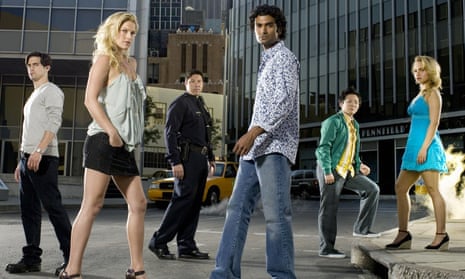There, up in the sky … is it a bird? Is it a plane? Or just a TV hit that flew too close to the sun and notoriously flamed out? When it launched in 2006, Heroes was a fantasy drama with an unusually international outlook for a US network show. Centred around a fateful eclipse that gifted oblivious civilians around the globe with preternatural talents, it disguised its pulpy superhero origin stories with questing new age philosophy (“What is the soul?” pondered the opening narration of the premiere). This was an X-Men knock-off framed as an aspirational TED talk, offering a refreshingly normcore take on long-existing comic-book mythologies.
For mid-2000s audiences already primed by the cryptic world-building of Lost, this was moreish stuff. Even if the populous cast initially seemed a little diffuse – what was the connection between Japanese office drone-turned space-time manipulator Hiro and clairvoyant NYC artist Isaac? – it meant that the plot was always barrelling forward, flipping through its grab-bag of settings and storylines before any of them could outstay their welcome. As well as the overarching mystery of the eclipse itself, Heroes introduced other symbolic chew-toys such as a recurring mysterious helix and a nifty mantra beamed from the future: “Save the cheerleader, save the world.” That gave fans plenty to ponder while they awaited the next episode (or “chapter” as the show’s slightly self-regarding terminology would have it). To the credit of creator Tim Kring and his team of writers, they kept this cosmic plate-spinning going for the 23 chapters that comprised season one. The finale also did an impressive job of bringing its scattered troupe together to avert an apocalypse heralded by brain-consuming supervillain Sylar. The climactic battle featured fights, flights, an unexpected twist and a moving moment of sacrifice. What more could you want?
The answer turned out to be: lots more. After season one’s global impact, Kring’s plan was to expand as quickly as possible. Season two would be 30 episodes long, a multi-tentacled epic broken into three 10-chapter “volumes”. More characters. More powers. More helixes. He might even have pulled it off, were it not for the Kryptonite of a trade dispute that saw US screenwriters go on strike in late 2007.
The ambitious season two plan was downsized to 11 chapters but even before the industrial action kicked off, audiences seemed ambivalent about the changes in emphasis. New characters struggled to make an impact while existing ones – notably fan-favourite Hiro, now apparently abandoned in feudal Japan – felt sidelined. If you’re trying to go faster than a speeding bullet, momentum is vital, and after that stunted second go-round, Heroes never fully recovered its mojo, trundling on for two more seasons before being cancelled by NBC seemingly as an afterthought. By then, of course, Robert Downey Jr had strapped on his rocket boots and inaugurated another superhero universe. Poor Heroes was always going to be eclipsed.

Comments (…)
Sign in or create your Guardian account to join the discussion